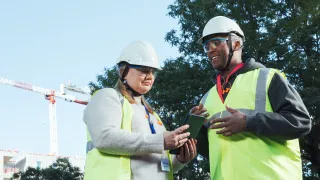Finnish Institute of Occupational Health media release 7 May 2025
The "Mitä kuuluu pelastustoimen työhyvinvoinnille 2023 ja 2024" (well-being at work in the rescue sector in 2023 and 2024) situational picture published by the Finnish Institute of Occupational Health is mostly positive. The share of people who are well recovered from work is 64 per cent, compared to 52 in the previous year. At the same time, the number of people who are poorly recovery has decreased from 27 per cent to 17 per cent. A total of 72 per cent of respondents felt that their work ability was good, which is four per cent more than in the previous year. However, only 42 per cent of first responders and 30 per cent of paramedics expect to continue working until retirement age.
"Changes will often increase workload. The second year of operations of the wellbeing services counties has clarified and calmed down the situation in rescue services, which may explain the improvement in well-being at work," says Jaana Laitinen, Research Professor at the Finnish Institute of Occupational Health.
Rescue sector well-being at work is part of society’s crisis resilience
Rescue services are a key party during exceptional circumstances, but only a first responder who is well can act safely and efficiently. That is why developing well-being at work in the rescue sector is also important from the perspective of preparedness and crisis resilience.
There are three key development themes that emerge from the situational picture of well-being at work in rescue services:
1. supervisors’ coping
2. prevention of inappropriate treatment
3. fostering a trust-based culture of discussion.
Developing these three themes in parallel forms the basis for a sustainable and safe work community and also bolsters the attractiveness and retention of rescue services.
“There is a strong connection between the development themes, as the prevention of inappropriate treatment strengthens trust, which, together with the improvement of supervisors’ well-being, is a key prerequisite for building and maintaining a culture of open interaction,” says Kirsikka Selander, Specialist Researcher at the Finnish Institute of Occupational Health.
Specific development needs for different professional groups within rescue services
There are major differences in well-being at work between different occupational groups among rescue services.
The recent situational picture divides rescue services into five different occupational groups, each with a different profile of well-being at work:
1. A first responder engaged in operational tasks
2. Immediate supervisor to first responders
3. Paramedic in rescue services
4. Administrative employee
5. On contract first responder
The situational picture lists the most important development needs and goals for well-being at work for each occupational group.
"Among first responders, there is particularly room for development in the openness of the discussion culture and the handling of negative emotions. Both of these can be strengthened by building psychological safety," says Nina Olin, Senior Consultant from the Finnish Institute of Occupational Health.
"Among paramedics, we observed accumulating stress in the form of low appreciation and recognition combined with violent behaviour by customers and discrimination. Information exchange between wellbeing services counties and the sharing of good practices are important measures for paramedics," Nina Olin continues.
Supervisors need more support from both their own supervisors and the work community. The work ability and recovery of those performing administrative work are at a lower level than others. What is significant for contractual first responders is the feeling of being an outsider: the opportunities to influence seem few and the flow of information feels poor.
Joint strategic document for the development of well-being at work in rescue services
Well-being at work affects work ability, work performance and safe work practices. It is a key retention factor, as health and work ability enable careers to continue for longer. The development of well-being at work in rescue services requires harmonisation.
"We need determined and long-term development of well-being at work, involving all wellbeing services counties and rescue service professionals. Our study highlighted the wish by different parties in the sector for a national strategic document on well-being at work in the rescue sector," says Jaana Laitinen, Research Professor from the Finnish Institute of Occupational Health.
Drawing up a joint strategic document requires a comprehensive analysis of the current situation as well as establishing objectives and indicators that can be used to systematically monitor progress and assess the effectiveness of measures. In addition, it is essential that different occupational groups are taken into account in the development work in order to create comprehensive solutions for the development of well-being at work for all rescue services.
Mitä kuuluu (How are we)? Well-being at work in the rescue sector study
- Mitä kuuluu pelastustoimen työhyvinvoinnille vuosina 2023 ja 2024 -tilannekuva (Julkari.fi, in Finnish)
- A total of 11 rescue services departments participated in the well-being at work survey in 2023 and 10 in 2024. In 2024, contracted first responders also participated in the survey for the first time.
- Representatives of the organisations that participated in the survey also participated in a development workshop, where the results of the survey and the factors behind them were discussed.
- Please find further information on the Well-being at work in the rescue sector website.
Further information
- Jaana Laitinen, Research Professor, Finnish Institute of Occupational Health, jaana.laitinen [at] ttl.fi, +358 30 474 6006
- Kirsikka Selander, Specialist Researcher, Finnish Institute of Occupational Health, kirsikka.selander [at] ttl.fi, +358 30 474 3065
- Nina Olin, Senior Consultant, Finnish Institute of Occupational Health, nina.olin [at] ttl.fi, tel. +358 30 474 7528







